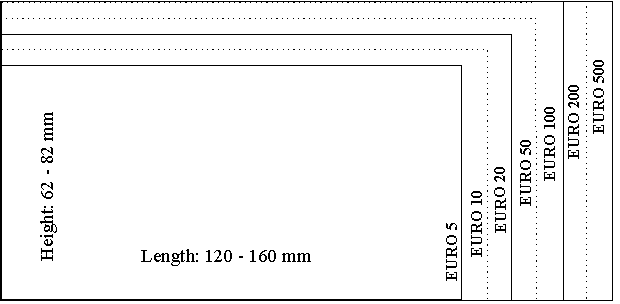The euro banknotes and the partially sighted
The EMI considers that it is important to reach the highest possible degree of acceptance by all users of the euro banknotes, including the blind and partially sighted. Fundamental to the independence of blind and partially sighted people is their ability to deal easily with money.
Numerous banknotes in EU countries currently incorporate marks enabling the blind and partially sighted to distinguish between denominations. Design features useful for people with partial sight are also often helpful to, and welcomed by, fully sighted people.
The current population of the European Union is about 370 million, of which close to 2% (about 7 million) have a significant visual disability.
Visual impairment is one of the most age-related of disabilities; the vast majority of blind and partially sighted people are elderly. Demographic trends show that the number of elderly people is on the increase.
The EMI had a fruitful co-operation with the European Blind Union. Design specifications for partially sighted people were included in the euro banknote design process from the outset, in order to obviate the need for later changes which would have been less efficient.
The needs of the blind and partially sighted have essentially been catered for by four different ways of differentiating between euro banknote denominations:
1. DIFFERENT SIZES OF THE BANKNOTES
In order to facilitate identification of the different denominations by the blind, the euro banknotes have different sizes according to their denomination.
EURO 5: 120 mm x 62 mm
EURO 10: 127 mm x 67 mm
EURO 20: 133 mm x 72 mm
EURO 50: 140 mm x 77 mm
EURO 100: 147 mm x 82 mm
EURO 200: 153 mm x 82 mm
EURO 500: 160 mm x 82 mm

2. MAIN COLOUR OF THE BANKNOTES
It is customary in banknote design in Europe for each denomination to have a single predominant colour. Colours used differ from each other as clearly as possible. Each denomination of the euro banknotes will be recognisable on the basis of a unique colour that will dominate on both sides of the banknote.
EURO 5: grey
EURO 10: red
EURO 20: blue
EURO 50: orange
EURO 100: green
EURO 200: yellow-brown
EURO 500: purple
3. PRINTING WITH TACTILE PROPERTIES
Marks which have a good tactility will help partially sighted people to distinguish between different denominations by touching them. Deep engraving and intaglio printing make it possible to print a high tactile ink relief. The marks will be positioned near an edge or a corner of the banknote.
4. CLEARLY VISIBLE AND LEGIBLE NUMERALS
Large and bold numerals will be located in a standard position throughout the series and on both sides of the banknotes. For instance:
100
These clearly visible numerals will assist partially sighted people in determining the direction to insert banknotes into banknote-accepting machines.
Европейска централна банка
Генерална дирекция „Комуникации“
- Sonnemannstrasse 20
- 60314 Frankfurt am Main, Germany
- +49 69 1344 7455
- media@ecb.europa.eu
Възпроизвеждането се разрешава с позоваване на източника.
Данни за контакт за медиите

